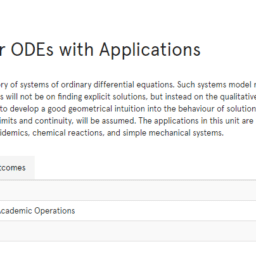MY-ASSIGNMENTEXPERT™可以为您提供sydney MATH3063 Ordinary Differential Equations常微分方程的代写代考和辅导服务!
这是悉尼大学 常微分方程课程的代写成功案例。

MATH3063课程简介
This unit of study is an introduction to the theory of systems of ordinary differential equations. Such systems model many types of phenomena in engineering, biology and the physical sciences. The emphasis will not be on finding explicit solutions, but instead on the qualitative features of these systems, such as stability, instability and oscillatory behaviour. The aim is to develop a good geometrical intuition into the behaviour of solutions to such systems. Some background in linear algebra, and familiarity with concepts such as limits and continuity, will be assumed. The applications in this unit are from biology, physics, chemistry, and engineering, including population dynamics, epidemics, chemical reactions, and simple mechanical systems.
Prerequisites
At the completion of this unit, you should be able to:
- LO1. explain the principle of linear approximations to nonlinear systems and use this to analyse system behaviour close to steady states
- LO2. synthesise graphical information from nullclines and flow to construct qualitative phase plane solutions to problems in nonlinear systems
- LO3. demonstrate knowledge of the theory of existence and uniqueness, and the determination of stability of solutions of ordinary differential equations, including special cases such as Hamiltonian and gradient systems.
- LO4. interpret model results and evaluate and explain the limitations of models in representing real systems
- LO5. demonstrate a broad understanding of the role of basic bifurcations in nonlinear systems and evaluate the effect of parameter variation on observed model behaviour
- LO6. apply mathematical theory in novel and diverse applications.
MATH3063 Ordinary Differential Equations HELP(EXAM HELP, ONLINE TUTOR)
Find the exact solution of the initial value problem
$$
y^{\prime}=y^2, \quad y(0)=1 .
$$
Starting with $y_0(x)=1$, apply Picard’s method and calculate the 4 first iterations. Then compare these results with the exact solution.
Find the exact solution of the initial value problem
$$
y^{\prime}=2 x(1+y), \quad y(0)=0 .
$$
It is worth noticing that it is not reasonable to use the method of Laplace transform to find the exact solution. Why may this method actually not work, what would be the explanation for this? Hint: what can you say about the growth of the exact solution?
Starting with $y_0(x)=0$, apply Picard’s method and calculate the 5 first iterations. Then compare these results with the exact solution.
Picard’s method can work with choices of the initial approximations other than the constant functions $y_0(x)=y_0$. Apply the methods to the initial value problem
$$
y^{\prime}=x+y, \quad y(0)=1,
$$
with the choices
(1) $y_0(x)=e^x$;
(2) $y_0(x)=1+x$;
(3) $y_0(x)=\cos (x)$;
What do you think, is it important to choose an initial approximation $y_0(x)$ that satisfies the initial condition, i.e. $y_0(0)=1$ ? Could the method work for the above problem for instance choosing $y_0(x)=x$ ? Or $y_0(x)=\sin (x)$ ? What do you think, why or why not?
Show that $f(x, y)=y^{\frac{1}{2}}$
(1) does not satisfy a Lipschitz condition on the rectangle $x \in[-1,1], y \in[0,1]$;
(2) does satisfy the Lipschitz condition on the rectangle $x \in[-1,1], y \in[c, d]$, where $0<c<d$.
What can you say about the solutions of the differential equation $y^{\prime}=\sqrt{y}$, equipped with an initial condition $y\left(x_0\right)=y_0$ when $\left(x_0, y_0\right)$ belong to the closed rectangles in (1) and (2)?
Show that $f(x, y)=x^2|y|$ satisfies the Lipschitz condition on the rectangle $x \in[-1,1], y \in[-1,1]$ but that $\frac{\partial f}{\partial y}$ fails to exist at many points of this rectangle. What can we say about the existence and uniqueness of solutions to $y^{\prime}=x^2|y|$, if $\left(x_0, y_0\right) \in[-1,1] \times[-1,1]$ ?

MY-ASSIGNMENTEXPERT™可以为您提供SYDNEY MATH3063 ORDINARY DIFFERENTIAL EQUATIONS常微分方程的代写代考和辅导服务!




